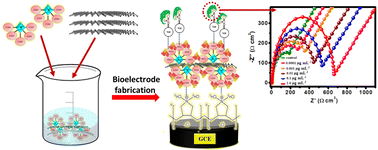The aim of the present study was to design a unique bioelectrode for the quantitative analysis of a potential cancer biomarker, platelet-derived growth factor-BB (PDGF-BB), which can be used for the early detection of cancer. We report the fabrication of succinic acid-capped selenomolybdate polyoxometalate nanodots, POM (SA), decorated antimonene hybrid film on glassy carbon as a suitable bioelectrode. Antimonene nanosheets, synthesized by the chemical exfoliation of antimony provided a large surface area for the symmetric dispersal of POM (SA) nanodots, resulting in site-specific covalent immobilization of the aptamer, PDGF-BB. A comprehensive electrochemical immunosensing investigation was performed on the electrode for sensing of a target antigen, Ag-PDGF-BB. The sensitivity, selectivity, and reproducibility of the bioelectrode were investigated using a best-fit equivalent circuit model that fitted the impedance response. The bioelectrode showed a linear impedimetric response in a broad range for Ag-PDGF-BB (10 pM to 100 nM in pH 7.4 PB) with a limit of detection of 3.5 pM and sensitivity of 80 Ω cm2 per decade. The response sensitivity of the POM(SA)/antimonene hybrid based bioelectrode toward PDGF-BB was approximately ∼1.8-fold higher than that of the POM(SA) only modified bioelectrode. The dissociation constant of immunoreaction between the aptamer-functionalized bioelectrode and target Ag-PDGF-BB was 76 nM, indicating a high binding affinity between the aptamer PDGF-BB and target Ag-PDGF-BB on the electrode surface.
